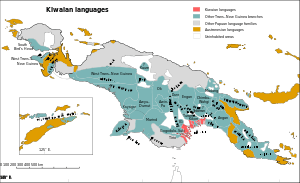Kiwaian languages
The Kiwaian languages form a language family of New Guinea. They are a dialect cluster of half a dozen closely related languages.[2] They are grammatically divergent from the Trans–New Guinea languages, and typically have singular, dual, trial, and plural pronouns.[3]
| Kiwaian | |
|---|---|
| Geographic distribution | Papua New Guinea |
| Linguistic classification | a primary language family |
| Glottolog | kiwa1251[1] |
 Map: The Kiwaian languages of New Guinea
The Kiwaian languages
Trans–New Guinea languages
Other Papuan languages
Austronesian languages
Uninhabited | |
Languages
Kiwaian languages and respective demographic information listed by Evans (2018) are provided below.[4]
List of Kiwaian languages Language Location Population Alternate names Southern Kiwai Kiwai Rural LLG 20,000 Island Kiwai Wabuda Kiwai Rural LLG 2,750 Bamu south Bamu Rural LLG 6,310 Northeast Kiwai West Kikori Rural LLG 6,000 Urama Kerewo West Kikori Rural LLG 1,090 Morigi West Kikori Rural LLG ?
Phonemes
Usher (2020) reconstructs the consonant inventory as follows:[5]
*m *n *p *t *s *k *b *d *g *w *ɾ
*i *u *e *o *a
Classification
The Trans–New Guinea identity of Kiwaiian is supported by a relatively large number of basic lexical items. Ross (2005) tentatively linked Kiwaiian to the erstwhile language isolate Porome. However, the evidence is only two pronouns, and the connection has not been accepted by other researchers.
Evolution
Kiwaian reflexes of proto-Trans-New Guinea (pTNG) etyma are:[3]
Southern Kiwai language:
- magota ‘mouth’ < *maŋgat[a]
- amo ‘breast < *amu
- gare ‘ear’ < *kand(e,i)k(V]
- pitu ‘fingernail’ < *mb(i,u)t(i,u)[C]
- baba ‘father’ < *mbapa
- sagana ‘moon’ < *takVn[V]
- tuwo ‘ashes’ < *sumbu
- era ‘tree’ < *inda
- nimo ‘louse’ < *niman
- epuru ‘head’ < *kV(mb,p)utu
- kopu ‘short’ < *kutu(p,mb)a
- abida ‘sister’ < *pi(n,nd)a
Other languages:
References
- Hammarström, Harald; Forkel, Robert; Haspelmath, Martin, eds. (2017). "Kiwaian". Glottolog 3.0. Jena, Germany: Max Planck Institute for the Science of Human History.
- https://sites.google.com/site/newguineaworld/families/kiwai
- Pawley, Andrew; Hammarström, Harald (2018). "The Trans New Guinea family". In Palmer, Bill (ed.). The Languages and Linguistics of the New Guinea Area: A Comprehensive Guide. The World of Linguistics. 4. Berlin: De Gruyter Mouton. pp. 21–196. ISBN 978-3-11-028642-7.
- Evans, Nicholas (2018). "The languages of Southern New Guinea". In Palmer, Bill (ed.). The Languages and Linguistics of the New Guinea Area: A Comprehensive Guide. The World of Linguistics. 4. Berlin: De Gruyter Mouton. pp. 641–774. ISBN 978-3-11-028642-7.
- New Guinea World, Kiwai
External links
- Timothy Usher, New Guinea World, Proto-Kiwai